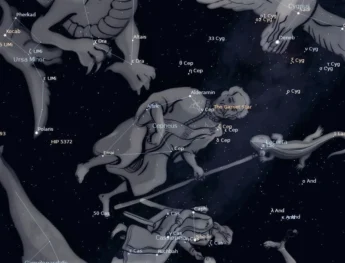This Week’s Sky at a Glance, 2023 August 5 – August 12
The constellation Cepheus the King is quite large but it can be difficult to pick out. Around 9:30 pm, look northward for a group of five moderately bright stars in the shape of a house on its side and situated above the W-shape of Cassiopeia the Queen. The peak of the house is only about a fist-width to the right of Polaris, the North Star, and the constellation lies just below a line from Polaris to Deneb at the tail of Cygnus the Swan. A colourful star can be seen in binoculars or a scope just below the base of the house. Herschel’s Garnet Star, a red supergiant, is one of the most luminous stars known and is a thousand times wider than the Sun. If placed in the middle of our solar system it would stretch beyond the orbit of Jupiter.
Another famous star in Cepheus is Delta Cephei, which is situated near the bottom left of the house; it being the namesake of the Cepheid variable stars. Such giant stars pulsate with a regular period and subsequently dim and brighten consistently over that time. For example, Delta Cephei dims and brightens by a factor of two over about five days. Early in the 20th century, Harvard astronomer Henrietta Swan Leavitt discovered that the intrinsic brightness of a Cepheid variable was proportional to its period and worked out a formula for this relationship. Using the 100-inch telescope on Mount Wilson in the 1920s, Edwin Hubble detected Cepheid variables in what was then called the Andromeda Nebula. Knowing the intrinsic brightness of these stars based on their periods, and how stars dim with distance, he determined the distance to these stars and proved that the nebula was actually a galaxy outside of the Milky Way.
This Week in the Solar System
Saturday’s sunrise in Moncton is at 6:05 am and sunset will occur at 8:43 pm, giving 14 hours, 38 minutes of daylight (6:13 am and 8:46 pm in Saint John). Next Saturday the Sun will rise at 6:14 am and set at 8:33 pm, giving 14 hours, 19 minutes of daylight (6:21 am and 8:36 pm in Saint John).
The Moon is at third quarter and above Jupiter on Tuesday morning. Mercury sets an hour after sunset this weekend and reaches greatest elongation from the Sun on Wednesday. Mars is a binocular width upper left of Mercury but dimmer and difficult to see. Venus is too close to the Sun for comfortable viewing but it will pop up in the morning sky later in the month. Saturn will be high enough in late evening to give decent views of its rings in a telescope. Jupiter rises around midnight this week and will be well placed for early morning observing. The Perseid meteor shower peaks next weekend with little interference from moonlight.
The Saint John Astronomy Club meets this Saturday at the Rockwood Park Interpretation Centre at 7 pm. There will be public observing at the Irving Nature Park in Saint John on August 11 at 9 pm, with a back-up date of August 12.

